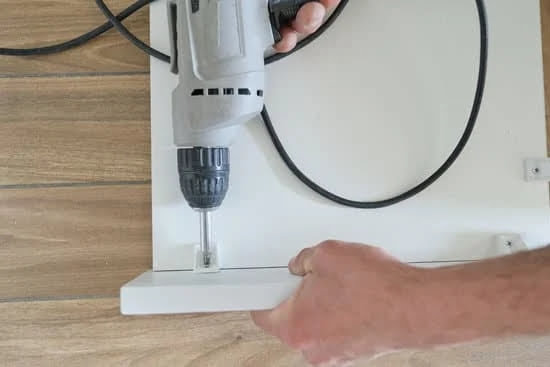Are you wondering how to paint woodwork in your house? Whether you’re looking to refresh the look of your interior woodwork or add a pop of color to your trim, painting woodwork can be a satisfying and budget-friendly DIY project. In this article, we will guide you through the process of painting woodwork in your house, from preparing the surfaces to choosing the right type of paint and achieving a professional finish.
Before you begin, it’s essential to gather the necessary materials and tools for the job. From sandpaper and primer to brushes and paint, having the right supplies on hand will make the process go smoothly. Once you’re ready to get started, we’ll walk you through the steps of preparing the woodwork for painting, including cleaning and sanding.
Choosing the right type of paint for woodwork is crucial for achieving a durable and long-lasting finish. We’ll discuss different options such as latex or oil-based paints, as well as considerations for different types of wood surfaces. With our step-by-step guide, you’ll learn how to apply primer, paint, and finish coats to achieve a professional look.
Additionally, we’ll share some tips and tricks for avoiding common painting mistakes and how to fix them if they occur. If you’re ready to freshen up your home by painting woodwork, keep reading for everything you need to know.
Necessary Materials and Tools for the Job
Painting woodwork in your house requires the right materials and tools to ensure a smooth and professional finish. Here is a list of necessary items that you will need:
- Paintbrushes and/or paint sprayer: Choose high-quality brushes and sprayers to apply the paint evenly on the woodwork. Synthetic bristle brushes are best for water-based paints, while natural bristle brushes work well with oil-based paints.
- Sandpaper: Use different grits of sandpaper to smooth the surface of the woodwork before painting. Start with a coarse grit to remove any imperfections, then use finer grits to create a smooth surface for the paint.
- Painter’s tape: Use painter’s tape to mask off areas that you do not want to paint, such as walls or floors adjacent to the woodwork.
- Primer: Depending on the type of wood and the condition of the surface, you may need a primer before applying the paint. A good quality primer will help the paint adhere better and provide better coverage.
- Paint: Choose the right type of paint for your woodwork, whether it’s latex, acrylic, or oil-based. Consider factors such as durability, sheen, and ease of cleanup when selecting your paint.
- Drop cloths: Protect your floors and furniture with drop cloths or plastic sheeting to catch any drips or spills during the painting process.
In addition to these essential items, make sure you have a clean container for mixing paint, stir sticks for stirring paint, gloves, safety goggles, and a ladder if needed for reaching high areas. Having these materials and tools ready before you start will make the painting process much smoother and more efficient.
Preparing the Woodwork for Painting (Cleaning, Sanding, Etc)
When it comes to painting woodwork in your house, proper preparation is essential for achieving a professional and long-lasting finish. Before you even think about picking up a paintbrush, you should gather all the necessary materials and tools for the job. Here’s a handy list to make sure you have everything you need:
- Painter’s tape
- Drop cloths or plastic sheets
- Sandpaper (medium and fine grit)
- Tack cloth or damp cloth for cleaning
- Wood filler and putty knife
- Primer and paint suitable for wood surfaces
- Paintbrushes or rollers
Once you have everything you need, it’s time to prepare the woodwork for painting. Start by protecting the surrounding area with drop cloths or plastic sheets, and use painter’s tape to mask off any areas that you don’t want to be painted.
Next, thoroughly clean the woodwork using a tack cloth or a damp cloth to remove any dust, dirt, or grime. This step is crucial as it ensures that the paint will adhere properly to the surface.
After cleaning, inspect the woodwork for any dents, holes, or imperfections. Use wood filler and a putty knife to fill in these areas, then sand the surface smooth once the filler has dried. Sanding is an important step in preparing the woodwork for painting as it creates a smooth and even surface for the paint to adhere to.
By following these preparatory steps, you can ensure that your woodwork is ready for a flawless paint job that will last for years to come. These simple yet crucial tasks can make all the difference in achieving a professional finish when painting the woodwork in your house.
Remember that proper preparation sets the foundation for a successful painting project. Without thorough cleaning and sanding, no amount of high-quality paint will be able to provide an optimal finish. Now that your woodwork is prepped and ready, it’s time to choose the right type of paint before moving on to actually applying it.
Choosing the Right Type of Paint for Woodwork
When it comes to painting woodwork in your house, choosing the right type of paint is crucial for achieving a long-lasting and professional finish. There are several factors to consider when selecting the appropriate paint for your woodwork, such as the type of wood, the location of the woodwork (interior or exterior), and your desired final look.
First and foremost, you’ll need to decide between oil-based and water-based paints. Oil-based paints are known for their durability and are ideal for high-traffic areas such as baseboards and window trim. On the other hand, water-based paints are easier to clean up and have less odor than oil-based paints, making them a popular choice for interior woodwork.
Additionally, you’ll need to choose between different finishes, such as matte, semi-gloss, or high-gloss. Matte finishes are perfect for achieving a subtle and understated look, while semi-gloss and high-gloss finishes provide more shine and are easier to clean.
It’s also important to consider any specific requirements for your woodwork. For example, if you’re painting outdoor woodwork, make sure to use a paint that can withstand exposure to the elements. Furthermore, if you’re painting over previously painted surfaces or stained woodwork, you may need a special primer or paint specifically designed for these situations.
| Types of Paints | Recommended Finishes |
|---|---|
| Oil-Based Paints | Semi-Gloss or High-Gloss |
| Water-Based Paints | Matte or Semi-Gloss |
| Specialty Outdoor Paints | Durable Finish (Satin or Gloss) |
Selecting the right type of paint for your woodwork can seem overwhelming at first, but by considering these factors and doing careful research on different products available in the market, you can ensure that your newly painted woodwork will not only look great but also stand the test of time. With proper care and maintenance, your freshly painted woodwork can continue to enhance the beauty of your house for years to come.
Step-by-Step Guide to Painting Woodwork (Primer, Paint, and Finish)
When it comes to painting woodwork in your house, following a step-by-step guide can help ensure that you achieve professional results. In this section, we will discuss the process of painting woodwork, from applying primer to adding the finishing touches.
Applying Primer
Before you start painting your woodwork, it is important to apply a primer. This will help the paint adhere better to the surface and provide an even finish. Use a brush or roller to apply the primer evenly, making sure to cover all areas of the woodwork.
Choosing the Right Paint
When it comes to selecting the right type of paint for your woodwork, consider using a satin or semi-gloss finish for a durable and easy-to-clean surface. Make sure to choose a paint specifically designed for use on wood surfaces for the best results.
Adding the Finishing Touches
Once the primer has dried completely, it’s time to apply the paint. Use a high-quality brush or roller to apply an even coat of paint to the woodwork. Allow the first coat to dry before applying a second coat for complete coverage and a professional finish.
By following these steps and paying attention to detail, you can achieve beautifully painted woodwork in your house that will enhance its appearance and durability for years to come.
Tips and Tricks for Achieving a Professional Finish
Achieving a professional finish when painting woodwork in your house requires attention to detail and the use of certain tips and tricks. To start, it’s important to properly prepare the woodwork for painting as discussed in the previous section. Once you’re ready to start painting, here are some tips that can help you achieve a smooth and flawless finish.
First, make sure to use high-quality brushes or rollers to apply the paint evenly. Using cheap or worn-out tools can result in streaks and an uneven application of paint. Additionally, choose the right type of paint for the specific type of woodwork you are painting. For example, if you are painting trim or baseboards, consider using a semi-gloss or high-gloss paint for durability and easy cleaning.
Another tip for achieving a professional finish is to apply thin coats of paint rather than trying to cover everything in one thick coat. Thin coats allow for better adhesion and drying, resulting in a smoother finish without brush marks or drips. It’s also important to follow the proper technique when applying the paint, such as starting from the top and working your way down, and using long strokes for an even application.
Furthermore, paying attention to detail is key when aiming for a professional finish. This means taking the time to tape off areas that you don’t want painted, such as walls or flooring, and using a steady hand when cutting in along edges. Don’t rush through the process – take your time and be patient for the best results.
In addition to these tips, keep in mind that practice makes perfect when it comes to painting woodwork. Don’t be discouraged if your first attempt doesn’t turn out exactly how you envisioned. With patience and persistence, you can improve your technique and achieve a professional finish with each project.
Dealing With Common Painting Mistakes and How to Fix Them
Uneven Paint Coverage
If you notice that the paint coverage on your woodwork is uneven, it could be due to a few different factors. One common cause is not applying an even coat of primer before painting. To fix this issue, you can sand down the uneven areas and apply another coat of primer before painting again.
Another cause could be using old or low-quality paint. In this case, sanding down the affected areas and applying a fresh coat of high-quality paint should solve the problem.
Drips and Runs in the Paint
Drips and runs in the paint can occur if too much paint is applied at once, or if the surface was not properly prepared before painting. To fix this issue, gently sand down the drips and runs once the paint has fully dried. Then, apply a thin coat of paint in the affected areas using a brush or roller, being careful not to overload with paint.
Paint Brush Marks or Roller Lines
If you notice visible brush marks or roller lines on your woodwork after painting, it may be due to using the wrong type of brush or roller, or not properly feathering out the edges while painting. To fix this issue, lightly sand down the affected areas and apply an additional thin coat of paint using a high-quality brush or roller. Take care to feather out the edges for a smooth finish.
By following these tips for fixing common painting mistakes, you can ensure that your woodwork will look professionally painted in no time. Regular maintenance such as dusting and mild cleaning will keep your newly painted woodwork looking fresh for years to come.
Caring for and Maintaining Newly Painted Woodwork in Your House
Once you have successfully painted the woodwork in your house, it is important to properly care for and maintain it to ensure that the paint job lasts for a long time. Proper maintenance will also keep your woodwork looking fresh and new. Here are some essential tips for caring for and maintaining newly painted woodwork in your house.
First and foremost, it is important to regularly clean the painted woodwork to prevent dust, dirt, and grime from accumulating on the surface. Use a soft cloth or sponge with mild soap and water to gently wipe down the woodwork. Avoid using abrasive cleaners or rough scrubbing, as this can damage the paint finish.
In addition to regular cleaning, you should also inspect the painted woodwork for any signs of wear and tear. Look out for chipped or scratched areas, as well as any spots where the paint may be peeling or flaking. It is important to address these issues promptly by touching up the paint as needed. This will help prevent further damage and maintain the overall appearance of the woodwork.
Another crucial aspect of caring for newly painted woodwork is protecting it from moisture and humidity. Excessive exposure to moisture can cause the paint to peel or blister over time. To prevent this, make sure to keep the area well-ventilated and use dehumidifiers if necessary, especially in areas such as bathrooms or kitchens where moisture levels tend to be higher.
| Tips for Caring for Newly Painted Woodwork | Maintenance Tips |
|---|---|
| Regularly clean the painted woodwork with mild soap and water | Address any chipped or scratched areas promptly by touching up the paint |
| Inspect for signs of wear and tear | Protect woodwork from moisture and humidity |
Additional Resources and Further Reading for DIY Enthusiasts
In conclusion, painting the woodwork in your house can be a rewarding and cost-effective way to update the look of your home. By following the necessary steps and using the right materials and tools, you can achieve a professional finish that will last for years to come.
From preparing the woodwork for painting to choosing the right type of paint and applying it in a step-by-step manner, this article has covered all the essential aspects of how to paint woodwork in your house.
For DIY enthusiasts looking to further expand their knowledge on this topic, there are plenty of additional resources and further reading available. Whether it’s online tutorials, books, or workshops, there are many opportunities to learn more about the best techniques for painting woodwork. By continuing to educate yourself on this subject, you can improve your skills and tackle more challenging projects in the future.
It’s important to remember that caring for and maintaining newly painted woodwork is crucial for its longevity. By regularly cleaning and inspecting the painted surfaces, you can prevent any potential issues and ensure that your hard work lasts as long as possible. With the right care, your newly painted woodwork will continue to enhance the beauty of your home for years to come.
Frequently Asked Questions
What’s the Best Way to Paint Woodwork?
The best way to paint woodwork is to start by preparing the surface – this may involve sanding, filling in any holes or imperfections, and priming the wood. Then, use a high-quality paintbrush to apply an even coat of paint, following the natural grain of the wood for the best results.
How Do You Paint Wood Trim in a House?
When painting wood trim in a house, it’s important to start by cleaning and prepping the surface. Use painter’s tape to protect the surrounding areas and apply a coat of primer before painting. Use a high-quality paintbrush or roller to apply an even coat of paint, being mindful of drips and streaks.
Do You Paint the Walls or Woodwork First?
It’s generally recommended to paint the woodwork first before moving on to the walls. This is because it’s easier to be precise when painting trim and woodwork, and if there are any drips or mistakes, they can be easily covered up when painting the walls afterward.
Painting in this order also helps create clean lines between the woodwork and walls.

Hi everyone! I’m a woodworker and blogger, and this is my woodworking blog. In my blog, I share tips and tricks for woodworkers of all skill levels, as well as project ideas that you can try yourself.





